
|   |

|   |
Tridhara presents the 8th Guru Debaprasad Award Festival - Nita Vidyarthi e-mail: nitavidyarthi@gmail.com Photos courtesy: Tridhara November 26, 2014 The annual Guru Debaprasad Award Festival (26th-28th Oct) at the Rabindra Mandap, Bhubaneswar, was inaugurated by Ashok Kumar Panda, Minister of Tourism and Culture, Government of Odisha. In its 8th year, the award to the top dancers of the country for their significant contribution to dance, was instilled in the memory of his guru by Guru Gajendra Panda, the devout and worthy disciple of the legendary Guru Debaprasad Das who is the pioneer in introducing “Sabdaswara pata” in the classical Odissi repertoire. Panda religiously propagates his guru’s ‘tridhara’ style which emphasizes equally on the incorporation of tribal, folk and classical streams into the dance form through his guru’s institution Tridhara. 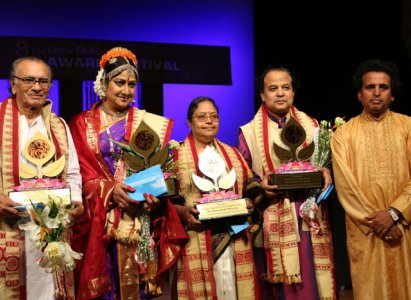 The awardees This year the award went to Bijayalaxmi Mohanty (Odissi), Jayant Kastuar (Kathak), Jatin Goswami (Sattriya) and actress-dancer Manju Barggavee (Kuchipudi).On this occasion the Hindi version of the book “Chausathi Yogini” (64 Yoginis) by the late Suresh Kumar Balabantaray was released in the presence of his wife, the day being the 60th birth anniversary of the author. 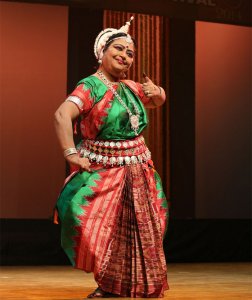 Bijayalaxmi Mohanty The inaugural evening saw a short Odissi recital by Bijayalaxmi Mohanty who was lost in oblivion for the past 20 odd years after performing the world over. Once a promising and brilliant dancer and the first girl to perform ‘Bandha nritya’ at the age of 4, she comes back to stage after 15 years at the special request of Gajendra Panda. A bit nervous, Bijayalaxmi began with a slow mangalacharan “Ganesh Vandana” embellished with “sabdaswara pata” followed by the abhinaya “Heiti ma keyeti kunja kutirey” penned by Kavi Gopal Krushna set to raga Mukhari with a compelling portrayal of vatsalya rasa. In the ashtapadi “Yahi Madhava” she almost brought back her old magical spell of abhinaya with fine musical support by Guru Dhaneswar Swain on the ukuta, Gajendra Panda on the manjira, Agnimitra Behera on the violin, Swapneswar Chakravarty on the sitar and vocal support by Binod Bihari Patnaik. 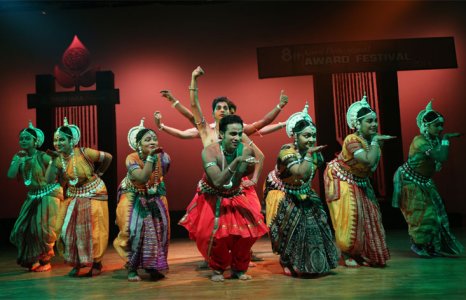 Yogini Yoga Roopa The dancers of Tridhara presented a novel composition “Yogini Yoga Roopa” interestingly choreographed by Gajendra Panda and scripted by Kedar Mishra on the 64 yoginis. The vibrant production opens with Shiva and Parvati sitting on a golden throne surrounded by Brahma, Vishnu, Indra, Lakshmi, Saraswati and other gods and goddesses when suddenly Shiva feels like dancing. He is accompanied by Saraswati on the veena, Indra on the taal vadya and others. On watching the lord dance, Parvati feels like dancing too and both break into a duet, when the gods say that Shiva is known for his tandava and Parvati for lasya, but there should be more of lasya element in the duet. On hearing this, Shiva starts meditating and his yogic power is manifested in the form of 64 yoginis. So out of Rudra’s meditative power, the yoginis are created. Gajendra Panda has featured 8 important yoginis briefly out of the 64 for constraint of time. The choreography was entirely in Debaprasad Das’ style with Sabdaswara pata very intelligently revolving round the name, character, consort, and attributes or symbols of these chosen 8, like Kalika, Chandika, Ramachandi, Bhadrakali and so on. The choreography does have a rustic touch, naturally incorporating folk elements like the Daskathia, some diagonal moves with the music using traditional instruments like the dhol, changu etc. used in villages to appease these village goddesses. Panda’s ‘Akhadapila’ background was reflected in the song “Chhan Chhan, Chandrahasa” and “Jagatmata Jagatjanahita Jogini Jogaroopa’ (from Tantra). Well rehearsed dancers, fascinating lights, vibrant dancing and colourful costumes with a good looking Shiva made for an entertaining production. Music was by Gopala Chandra Panda, assisted by Sangeeta Panda and ukuta by Guru Banamali Moharana. The second day opened with a soulful vocal recital by the versatile, veteran Hindustani vocalist and composer Pandit A. Maheshwar Rao. Specialising in the rendition of Sanskrit hymns and songs, the baritone and clarity of his velvety voice reverberated with the rhythmic “Madanmohan Ashtakam,” “Jaya shankha gadadhara” in Kaharba tala, raga Jog and Gavati adorned with “Pitapitambara dehi padam” and “Chandana charchita kundalamandita” in the cross lines. This was followed by a soft Deepchandi tala based “Prasida Bhabatarini.” His mellifluous recital concluded with the powerful “Nagendraharaya Trilochanaya” in taal Dadra by adiguru Shankaracharya. Ajoy Chand’s tabla, Srinibas Satpathy’s flute, A Narayanrao’s violin and Sanjib Sahoo’s manjira made for a rewarding recital. Flautist Pandit Ronu Majumdar’s recital began with some taans in Jai Jayanti Bageshree followed by a bandish in rupak taal. His breathing and blowing techniques as well as the kampans especially with the upper notes left the listeners in the packed auditorium spellbound. Maintaining a long breath, he presented an ektaal bandish of the Maihar Gharana and a ganey ki bandish, “Mere mandir ke aaj woh nahi aye” singing while playing. 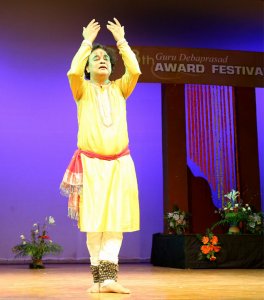 Jayant Kastuar That Jayant Kastuar is an accomplished dancer was proved once again in the evening’s recital. Opening with the joy-filled Ganesh vandana “Gayiye Ganapati jaga vandana,” the dancer moved on to demonstrate his extraordinary rhythmic wizardry of the Jaipur gharana in a bouquet of nritta items in spite of an injured foot and a new set of accompanists, specially the tabaliya who is so important in a Kathak recital. It was a feast of ‘Khula Nach’ with excellent footwork and captivating stances in vilambit teen taal, the usual Upaj (spot improvisation), Uthan and Thaat and “Tishra jati ka chalan” (an arithmetic of three) stressing at different matras polishing the rendition. The popular Meera bhajan “Chalomana Ganga Jamuna teer” was presented with sensitive abhinaya, blending gat bhav seamlessly. Elaborate gestures of animals, birds, saints and men offering Gangajal (water of the Ganges) to the dead added a new dimension to this common number. One missed on the thumri because of time constraint. 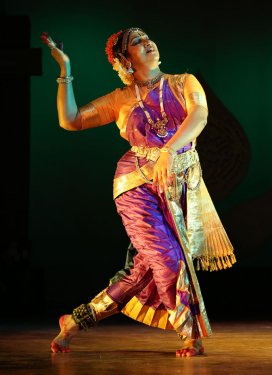 Manju Barggavee The awards were conferred in the closing ceremony on the last evening by ministers Debiprasad Mishra and Dr. Damodar Rout. As Guru Ramhari Das had mentioned in the previous evening, the dignitaries lauded Guru Gajendra for his endeavour in preserving and propagating his guru’s style and prevent re-choreographing of his authentic items. The first presentation of the evening was a Kuchipudi recital by Manju Barggavee who was the star attraction of the evening. She presented her guru Vempati Chinna Satyam’s compositions “Sanchara Dadhara” beginning as per her guru’s directive with the singing of “Yadi Hari Smaraney” to usher in the ashtapadi and then ‘Lekha,’ the famous letter sequence in Bhamakalapam set to raga Arabhi, adi tala in which the repentant Satyabhama writes a highly poetic letter to Krishna seeking his forgiveness. Barggavee excels with wonderful grace and charm in the sensitive mishra chapu based “Palukutenalatalli” where the sakhi asks Padmavati whether her smudged kumkum and dishevelled clothes were due to her spending the night with her Lord Venkatesha! 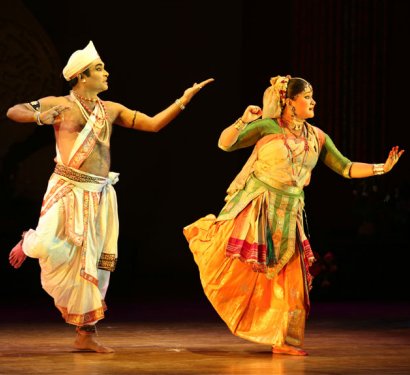 Prabhakar and Seujupriya Goswami It was a privilege to watch the veteran Sattriya Guru Jatin Goswami perform Sankaradeva’s ektaal based Krishna Vandana “Suni uko sarbajana Krishnacharitra” with effortless ease. The “kirtan-pada” saw the virtuoso in the best of forms. A Namghosa in chhutkala tala “Hey Krishna hey Vasudeva Devakinandan” composed by Sankaradeva and Madhavadeva was equally rewarding. His disciples Prabhakar and Seujupriya Goswami presented a compelling “Ram Vandana,” “Jaya Jaya Raghukula Pankaj Dinkara Rammurari” in raga Sindhura and ektaal and chhutkala, demonstrating good coordination in the fine chali and ramdani (pure dance). ‘Kaaliyadaman’ from Ankiya Bhaona, a solo by Seujupriya was a very convincing number involving Ojhapali and Ankiya Bhaona. She has emerged as a mature and competent dancer. ‘Arjun’ by Prabhakar was a dialogue in the war field between Krishna and Arjun prior to the Geetopadesha and was impressive. The program was very ably compered by Dr. Mrityunjay Rath and Srinibas Ghatuary. Dr. Nita Vidyarthi is a critic of performing arts, specialising in dance, dance theatre and expressions and is a regular contributor to The Hindu, and the Statesman Kolkata in dance, vocal music and theatre. She is trained in Kathak, Bharatanatyam and Manipuri as well as vocal, semi-classical music and Rabindra Sangeet. |